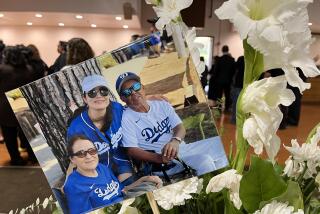‘Play Ball!’: Words to Remember Manzanar
- Share via
Baking in the California desert 220 miles northeast of Los Angeles and at the foot of Mt. Whitney sits what used to be a ballpark--one that wouldn’t even qualify for the minor leagues today but whose very presence is just as elemental to U.S. history as Ebbets Field.
The dirt diamond--its baselines still visible beneath 57 years’ worth of sagebrush--rests squarely along Highway 395 on the eastern border of what was once euphemistically called the Manzanar War Relocation Center.
By now, the history of Manzanar is well out of the shadows. In early 1942, Gen. John L. DeWitt and California Atty. Gen. Earl Warren--casting about for a reason to get rid of all Japanese Americans living on the West Coast--invented a kind of Silly Putty logic that promptly put the Bill of Rights on the endangered list.
“The fact that there have been no instances of espionage to date indicates how devious these people really are,” warned DeWitt, “and points to an almost certain plot in the future.”
The upshot was President Franklin D. Roosevelt’s Executive Order 9066, which resulted in the roundup of 120,313 aliens and “nonaliens” (i.e., citizens) and their deportation to federal concentration camps--generally with the loss of their homes, their property and anything else they couldn’t carry with them.
President Clinton’s $5-million appropriations bill allowed the Department of the Interior to honor the Americans whose Constitution was taken away from them during those three terrible years. But while the National Park Service is in the process of restoring the Manzanar site--complete with a visitors center, a block of barracks and regularly scheduled tours beginning in September 2003--the only plans for the baseball field consist of a free-standing marker somewhere around where home plate used to be.
This, as they say in Cooperstown, is an error of major league proportions--because a memorial to Manzanar without its baseball diamond is like the Pledge of Allegiance without the flag.
The importance of baseball to those incarcerated behind Manzanar’s barbed wire can’t be overstated: It was perhaps one of the few aspects of the lives they’d led prior to E.O. 9066 that they were allowed to keep with them after everything else had been taken away. In fact, although Manzanar wasn’t fully populated until June 1942, the camp’s newspaper from early May shows that there were already eight baseball teams in fierce competition. The diamond was one of the first things to go up, even before the school had been constructed.
Baseball was the bond that kept many of these families together during some pretty rough moments. It got them through the disappointing Supreme Court decisions upholding the constitutionality of the internment, and--as Americans--it got them through the rage and humiliation engendered by the loyalty questionnaire.
But would anybody break away from an otherwise somber pilgrimage to an internment camp for a photo op along a dusty first base line? Or a pickup game? Or even catch between father and son? One need look no further for an answer than Dyersville, Iowa--where people from all over the country still make Field of Dreams an out-of-the-way pit stop on their itineraries just to be able to play ball on the fabled diamond-in-a-cornfield.
To have the same sort of magic strike at Manzanar--this time between the generations and, even more significantly, between the cultures--would go a long way toward underscoring the message the park is meant to convey. Indeed, the inclusion of a diamond might achieve what reparations alone couldn’t: healing. Something like closure is best accomplished when a 12-year-old Caucasian kid tosses a ball to a 10-year-old Latino kid, who then throws it to an 11-year-old Asian. Especially when they don’t even know one other.
You couldn’t ask for a more human legacy than that.
More to Read
Go beyond the scoreboard
Get the latest on L.A.'s teams in the daily Sports Report newsletter.
You may occasionally receive promotional content from the Los Angeles Times.










